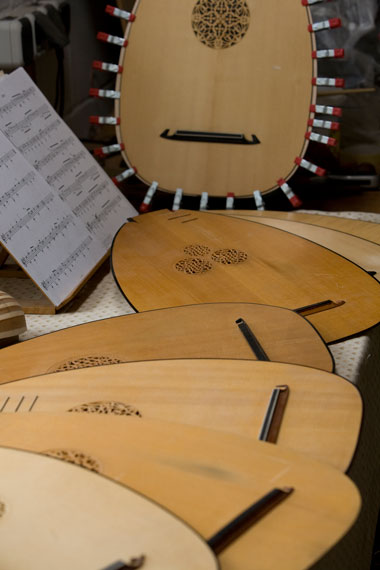About the Liuto forte
Early History
- Lute and guitar – a dilemma?
- Lute and guitar in the 20th century
- Why the lute died out
- Original instruments – original sound?
- The stringing of historical lutes
- Rift between guitar and lute
- Distinctions in sound
- Methods of guitar and lute construction
- The guitar’s limited bass range
About the Liuto forte
- A Lute for the 21st century
- “Guitar-lute“ or “authentic“ lute
- Historical Liuti forti
- Single or double strings?
- Liuto forte sound
- Liuto forte stringing
- Fingertips or nails?
- The belly
- Fine tuning
- The rose
- Fixed or tied-on frets?
- Tuning pegs
- The nut
- The fingerboard
- The bridge
- Playing position
- Playing technique
- Edition "Liuto forte & Guitar"
- Prospects
Edition "Liuto forte & Guitar"
The series "Liuto forte & Guitar" presents players of the Liuto forte with carefully edited versions of music from four centuries. One special aspect is the introduction to guitarists of lute music from the 16th to the 18th centuries which, although intended for more than six strings, can be happily rendered on the guitar.
For the transcription we have made use of the standard G clef, the familiar treble clef intended to be sounded an octave lower. The original text, in tablature, and its transcription in staff notation are presented together in score.
Lutenists will welcome the visible presentation of the musical structure in staff notation. Guitarists interested in the original fingerings will be able to consult the lute composers’ realisation of each piece in the accompanying tablature.

Lute pieces of the Renaissance – originally intended for ”alto lutes“ in G or ”descant lutes“ in A, unspecified of course by tablature – will be presented in the interests of easier legibility in the regular guitar notation (corresponding to the E tuning of the ”tenor lute”). Guitarists and players of the Liuto forte in E who wish for technical or aesthetic reasons to play at the higher pitch are recommended the use of a capo tasto.1
Especially interesting for players of the Liuto forte in e tuning will be transcriptions of works originally composed for the d minor lute (e.g. Sylvius Leopold Weiss). Contrary to the usual practice of guitar transcriptions which put the pieces into higher keys, thereby disfiguring the acoustical character of the originals beyond all recognition, we go the other way and transpose these works a tone or semitone lower, as is most convenient. This method, presupposing, of course, more than six strings at our disposal, brings astonishing results. Even with only three extra strings in the bass it is possible for the e tuning to get deceptively close to the sound of the original. The arranger, however, must be conversant with the qualities and style of the d minor lute before it can be at all established which pieces really lend themselves to an idiomatic rendition in a quite different tuning. Most of the transcriptions on the market for six string guitar suggest that in-depth experience was not considered a necessity for making baroque lute arrangements.
One of our particular aims is the presentation of a new literature for the Liuto forte. It is of absolute importance, of course, that the new instrument – like the Spanish guitar in the 20th century – should be nourished with original compositions. So far, it appears to be an easier task to motivate contemporary composers into writing for the new lute than was the case for the old lute.
1 The Liuto forte capo tasto is a modified version of the guitar capo manufactured by the firm of Shubb. It is perfectly matched to the fingerboard of the particular Liuto forte model.
Further information available: Hermann.Graefe@t-online.de.



